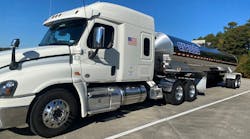The Pipeline and Hazardous Materials Safety Administration (PHMSA) is proposing to amend the Hazardous Materials Regulations by establishing standards for the safe transportation of bulk explosives. The Notice of proposed Rulemaking was published in the July 16 Federal Register, and comments are due by September 15.
The HM-233D rulemaking would be responsive to two petitions for rulemaking submitted by industry representatives: P-1557 concerning the continued use of renewal applications, and P-1583 concerning the incorporation of an industry standard publication. Essentially, PHMSA could hand off the responsibility for updating these regulations in the future to a third party.
The requirements of this proposed rule would mirror the majority of provisions contained in nine widely used or longstanding special permits that have established safety records, according to PHMSA officials. These proposed revisions are intended to eliminate the need for future renewal requests, thus reducing paperwork burdens and facilitating commerce while maintaining an appropriate level of safety. As proposed, the requirements would authorize the transportation of certain explosives, ammonium nitrates, ammonium nitrate emulsions, and other specific hazardous materials in bulk packagings, which are not otherwise authorized under the regulations. These hazardous materials are used in blasting operations on specialized vehicles, known as multipurpose bulk trucks, which are used as mobile work platforms to create blends of explosives that are unique for each blast site.
Finally, this rulemaking addresses the construction of new multipurpose bulk trucks. The NPRM proposes adopting a combination of features, including: incorporating by reference (IBR) the Institute of Makers of Explosives' (IME) Safety Library Publication Number 23 “Recommendations for the Transportation of Explosives, Division 1.5, Ammonium Nitrate Emulsions, Division 5.1, Combustible Liquids, Class 3 and Corrosives, Class 8 in Bulk Packaging” (referred to as SLP-23); requiring fire suppression systems in heat containing compartments (eg, engine, transmission, etc) and emergency shut-off/battery disconnect of newly constructed or modified multipurpose bulk trucks (MBTs); and complying with certain National Highway Traffic Safety Administration (NHTSA) requirements.
HMSA believes this NPRM will be of benefit to both the public and the industry, as it will: (1) Eliminate the need for firms to apply individually for the transportation of certain classes of bulk materials in MBTs, (2) provide regulatory flexibility and relief while maintaining a high level of safety, (3) promote safer transportation practices, (4) facilitate commerce, (5) reduce paperwork burdens, (6) protect the public health, welfare, safety, and environment, and (7) eliminate unnecessary regulatory requirements. Finally, with this rulemaking amending the HMR by incorporating IME publication SLP-23, the majority of provisions from nine special permits will be incorporated since those permits were used as the basis to create the SLP-23 document.
Over the past 10 years, there have been 35 reported transportation incidents in the United States involving multipurpose bulk trucks. During this same period, there has never been a death or major injury attributed to the hazardous materials while in transportation when there was compliance with the regulations. While there has been one incident that resulted in a fatality in that 10-year period, it involved a vehicular crash and human error, and was not attributed to the transportation of the hazardous materials themselves. Overall most incidents (90%) resulted in spillage; fewer incidents resulted in vapor dispersion (3%), environmental damage (0.5%), fire (0.5%), waterway infringement (0.4%), and explosion (0.1%.) Most of the time, the closures or covers in portable tanks failed, causing leaks.








